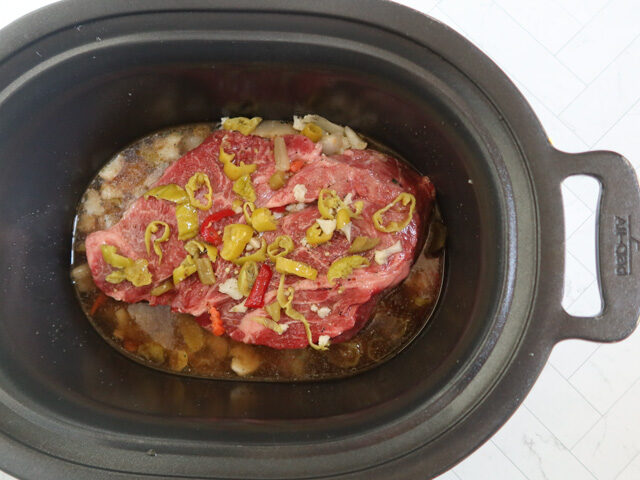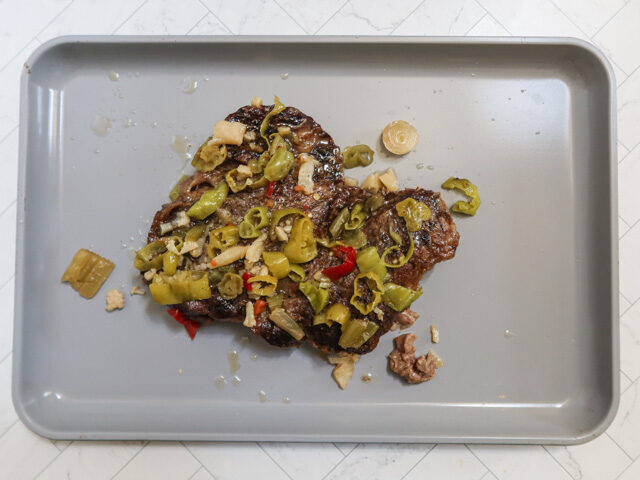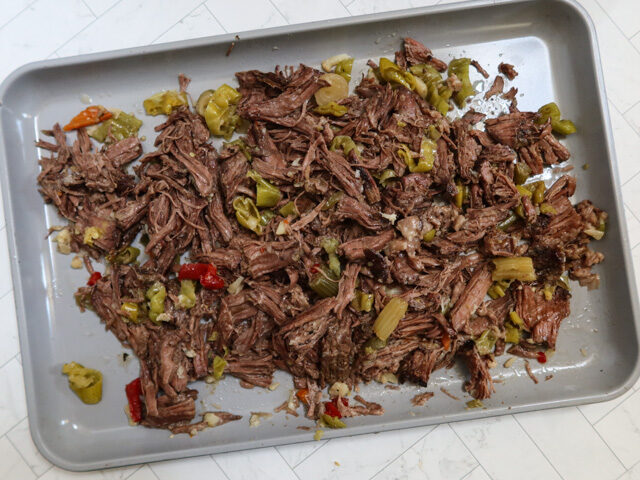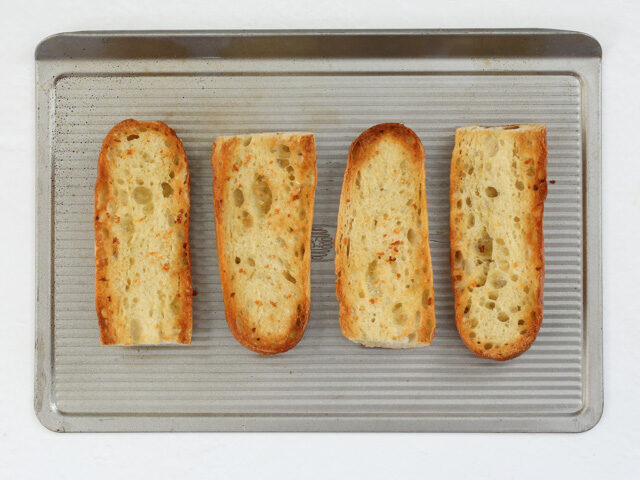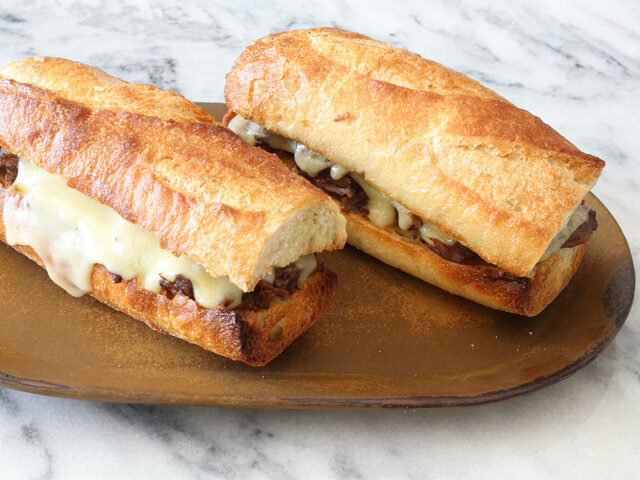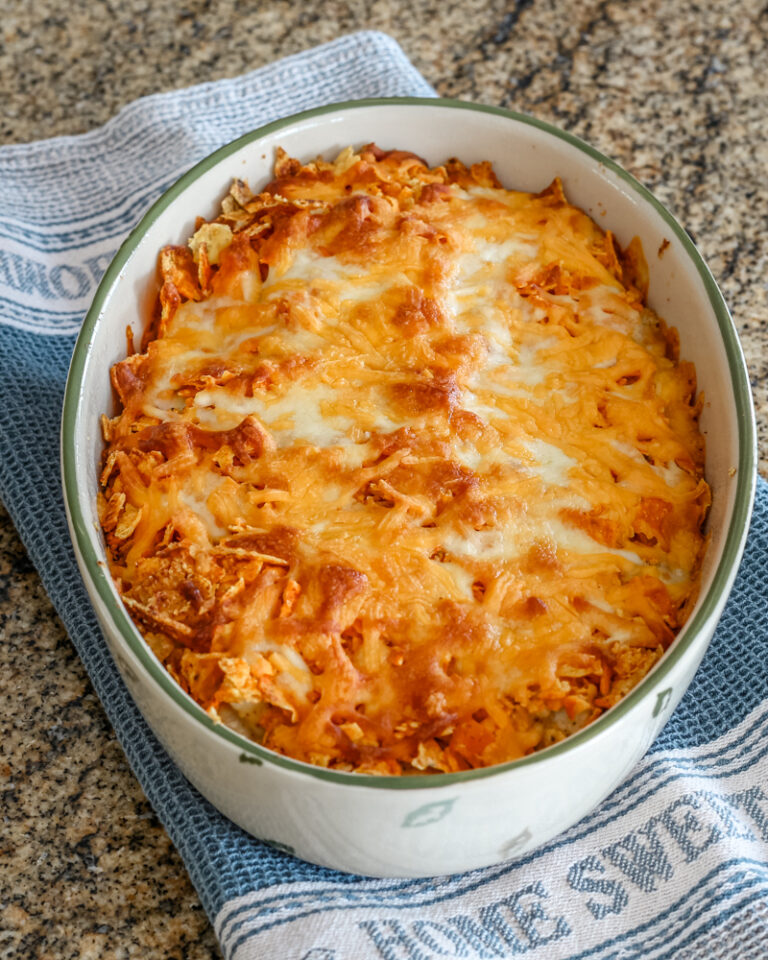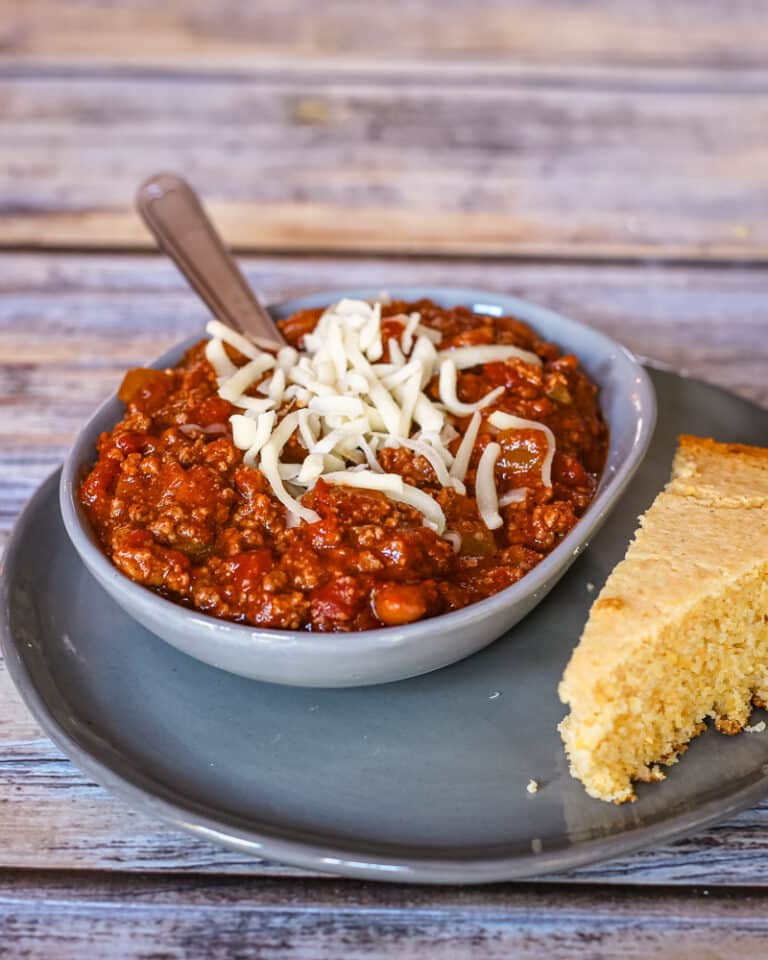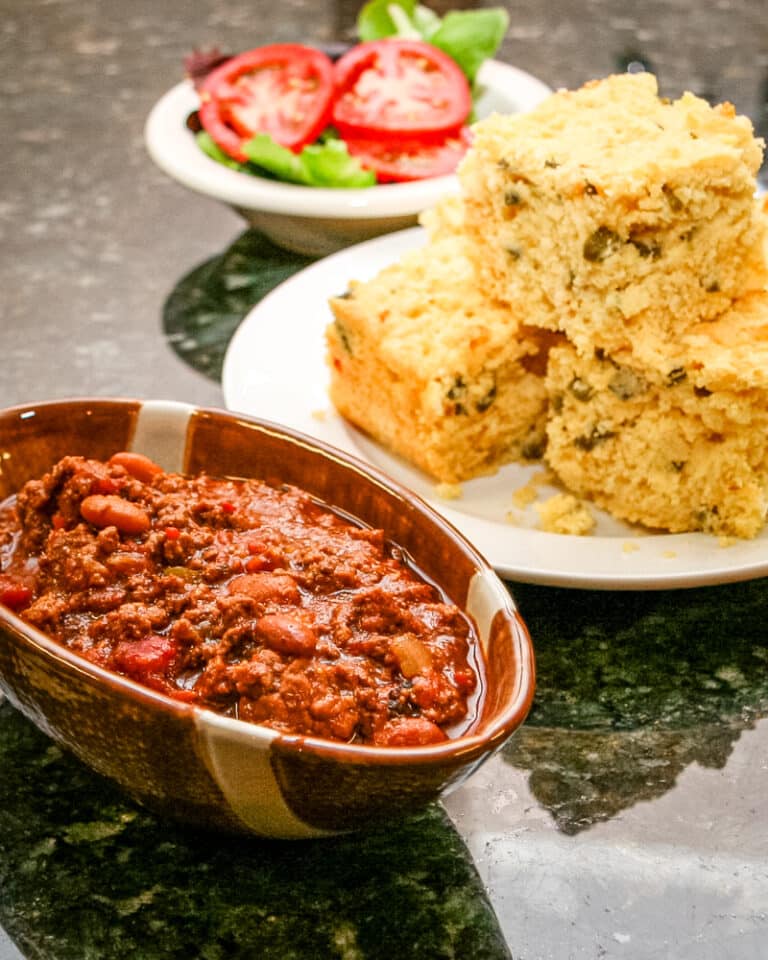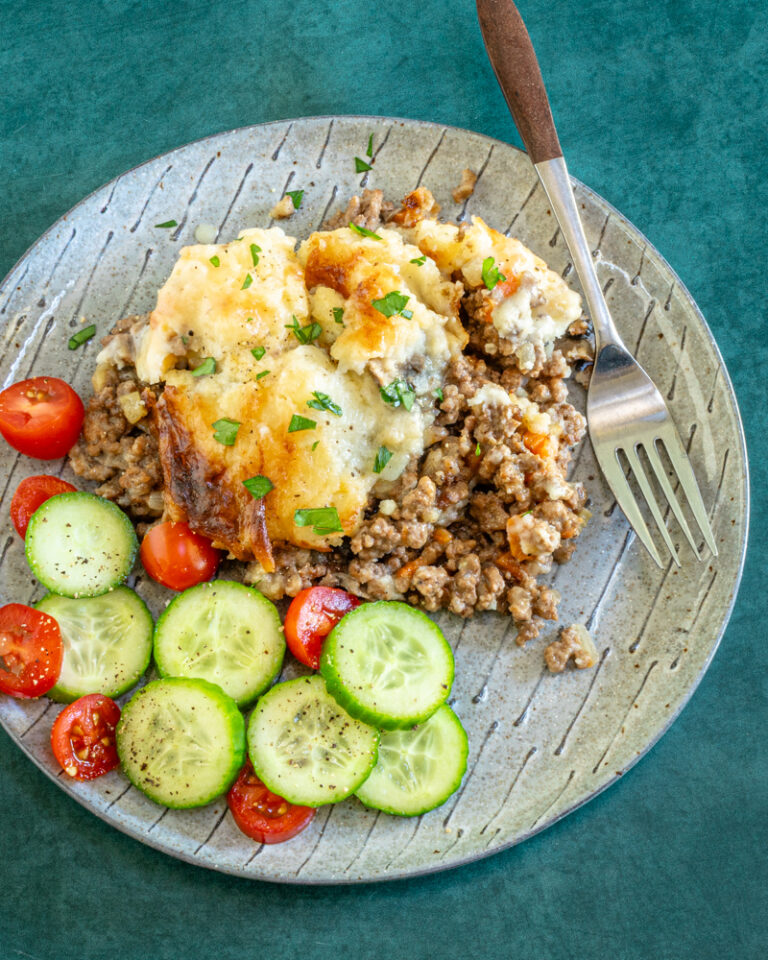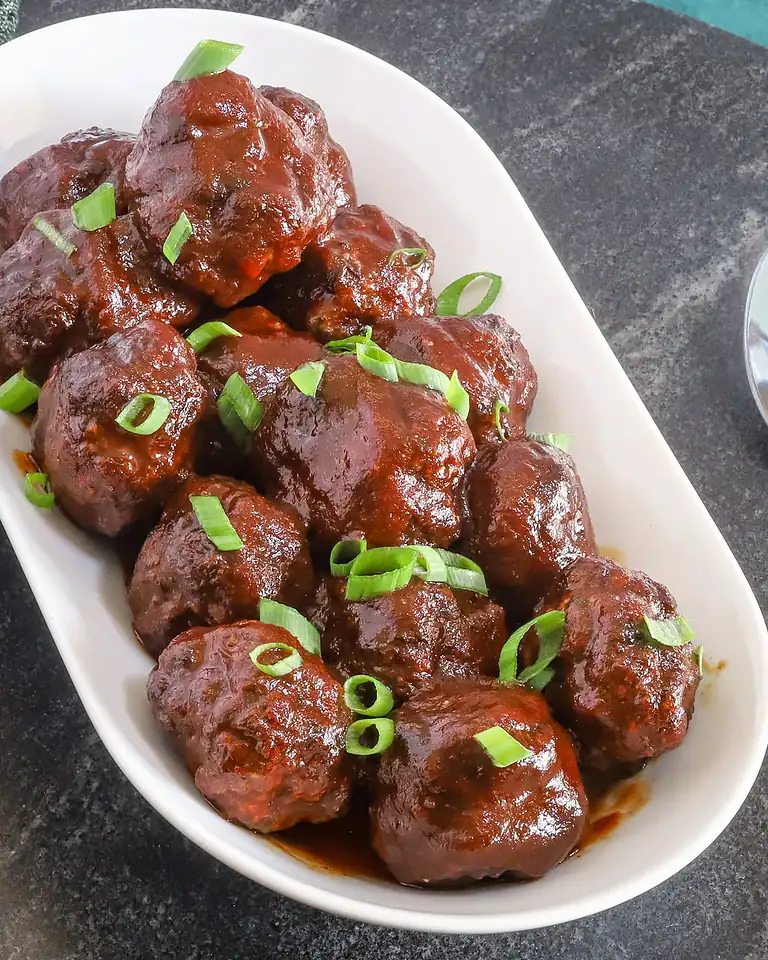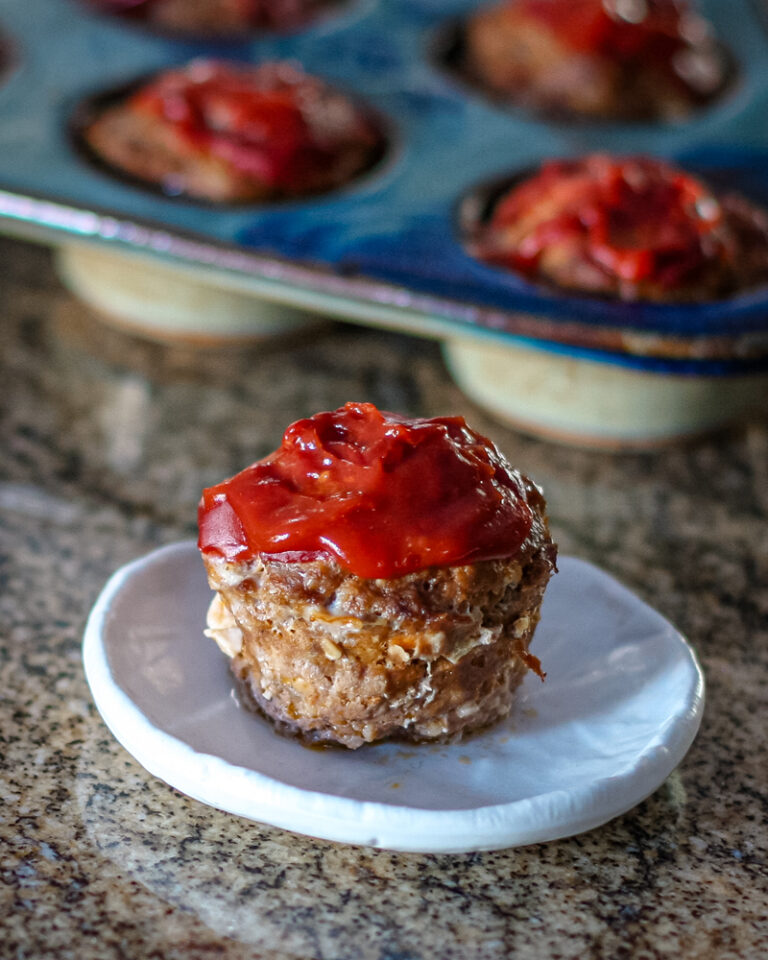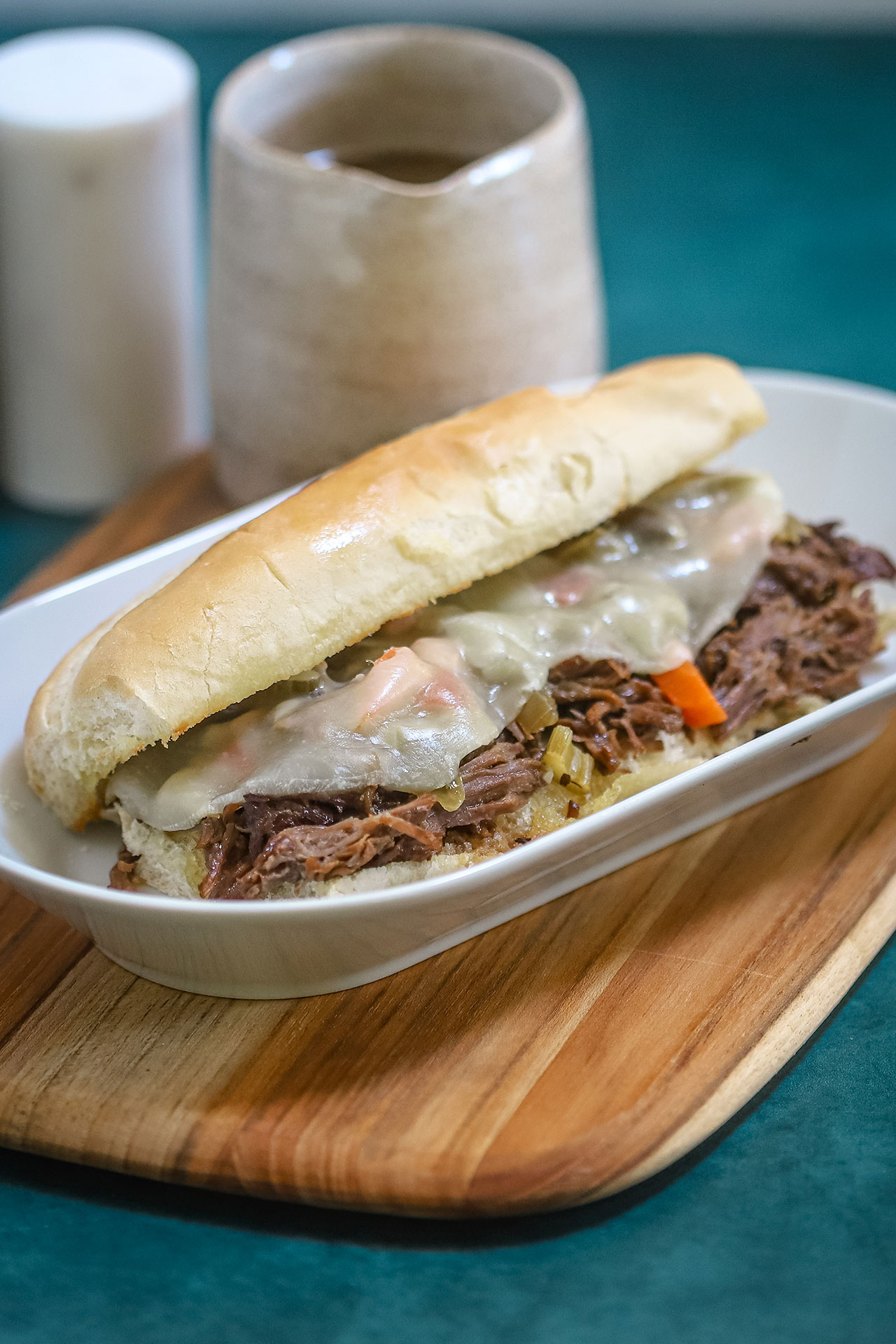Slow Cooker Italian Beef
Make delicious slow cooker Italian beef sandwiches at home. Tender beef, pickled peppers, and provolone cheese on a roll will satisfy your cravings.
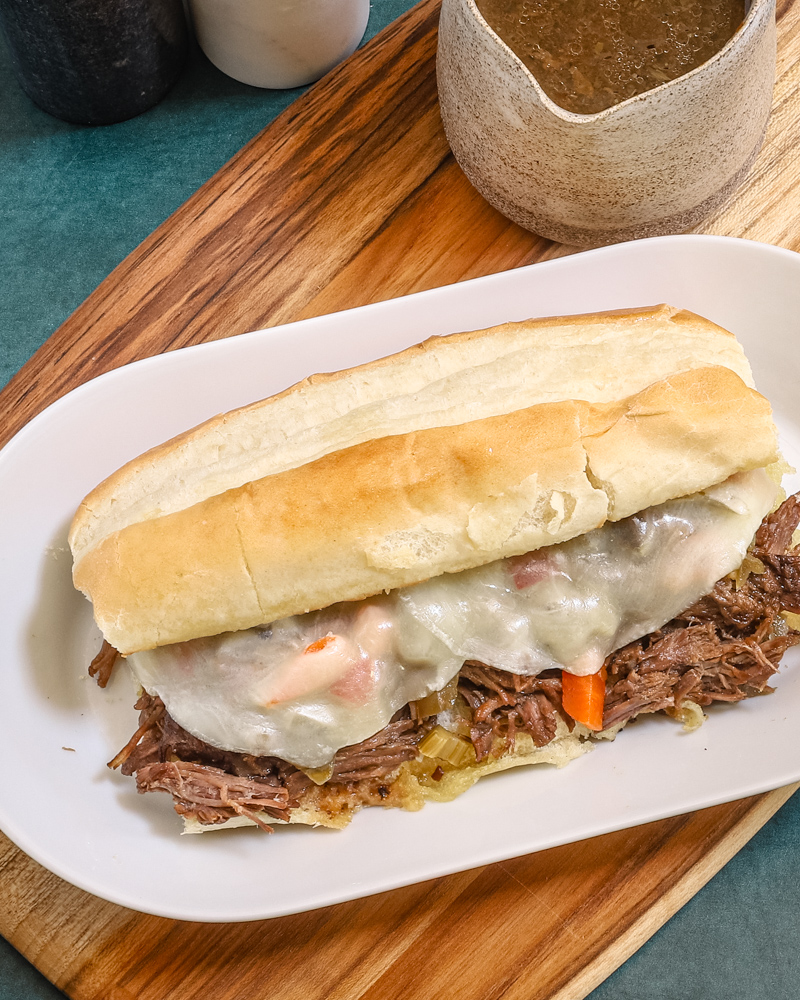
Whether for an everyday family meal, a potluck dinner, or a party or get-together with friends, slow cooker Italian beef sandwiches are always a hit. Basically, the dish starts with a tender, slow-cooked beef pot roast flavored with pickled peppers and vegetables. And preparation is a surprisingly simple—pop the meat and ingredients in the slow cooker and press the button. The slow cooker does the work! Shred the meat, pile it on toasted rolls, add pickled peppers and provolone cheese, and broil to melt the cheese. That’s all there is to it!
Originally created to feed large groups of people—weddings, parties, receptions, etc.—the sandwiches have been a Chicago tradition since the early 1900s. The typical Chicago sandwich is traditionally dipped in the reduced au jus. In our version, the jus is drizzled over the sandwich filling. There’s plenty of jus to go around, so feel free to also serve some on the side for those who prefer to dip their sandwiches!
Along with French dip and BBQ beef, this is one of my go-to beef recipes because it never fails. If you want a faster version, try our Instant Pot Italian beef sandwich recipe.
What You’ll Like About This Recipe
- Hands-off cooking. Once everything goes into the slow cooker, the beef cooks gently for hours with no need for checking or stirring, making this ideal for busy days or low-prep meals.
- Bold, layered flavor. Giardiniera, pepperoncini, and Italian dressing mix bring heat, tang, herbs, and acidity that cut through the richness of the beef and create a signature Italian beef profile.
- Supremely tender texture. Chuck roast becomes fall-apart soft in the slow cooker, shredding easily and absorbing the seasoning blend and juices.
- Perfect for gatherings. A single roast produces enough meat to serve a crowd, and diners can customize their sandwiches with extra peppers, cheese, or jus.
- Fantastic leftovers. The beef reheats beautifully and can be used for sandwiches, loaded baked potatoes, grain bowls, or even pizza toppings.
Ingredient Notes
- Beef chuck roast: A marbled cut that becomes tender and shreddable after slow cooking.
- Giardiniera: Pickled vegetables add briny, spicy flavor—use mild or hot, depending on preference.
- Pepperoncini + liquid: Adds tang and heat to the broth and the final sandwich.
- Italian salad dressing mix: A seasoning shortcut that infuses the meat with herby flavor.
- Beef broth: Enhances the meat’s richness and forms the base of the jus.
- Hoagie rolls: Toasted rolls stand up to the juicy beef and toppings.
- Provolone cheese: Melts beautifully and adds savory depth.
- Olive oil: Brushed on the rolls before broiling for a golden, toasty finish.
Steps to Make Slow Cooker Italian Beef Sandwiches
- Place the trimmed chuck roast into the slow cooker and add the giardiniera, pepperoncini, a splash of brine, Italian seasoning mix, and broth so the meat cooks fully surrounded by flavor.
- Let the roast cook low and slow until tender enough to shred easily. Longer cooking results in softer texture and deeper infusion of flavors.
- Strain the cooking liquid into a saucepan, then simmer to reduce and concentrate its tangy, beefy flavor into a perfect jus for drizzling or dipping.
- Shred the beef into bite-sized pieces so it absorbs the reduced liquid evenly and sits well in the sandwich without large chunks falling out.
- Toast the hoagie or sandwich rolls briefly to create a sturdy base that won’t soften too quickly under the juicy meat.
- Assemble the sandwiches with hot beef, peppers, melted provolone, and a drizzle of jus to achieve the classic Italian beef experience.
Pro Tips
- Trim large pockets of fat from the roast, but leave some marbling for moisture and tenderness as the beef cooks.
- Reserve some pepperoncini whole for topping; they add brightness and texture to the finished sandwich.
- Reduce the cooking liquid long enough to intensify flavor—you want a concentrated jus, not a thin broth.
- Toast the rolls to help them stand up to the rich, juicy beef and prevent sogginess.
- Serve with extra peppers, provolone, or jus on the side so each eater can customize the sandwich to their taste.
Recipe Variations
- Hot Italian beef. Add crushed red pepper flakes, hot giardiniera, or spicy pepperoncini to increase heat and create a Chicago-style “hot” version.
- Garlic-forward version. Add whole garlic cloves to the slow cooker for a deeper, roasted garlic note in the finished beef.
- Herb-heavy twist. Add fresh oregano, basil, or thyme during cooking for a more pronounced herbal profile.
- Cheesy melt style. Layer provolone over the shredded beef in the slow cooker for a few minutes before serving, allowing it to melt into the meat.
- French dip hybrid. Serve the beef on crusty rolls and present a warm cup of the reduced jus for dipping, blending Italian beef with a French dip feel.
Serving Suggestions
- Serve on toasted hoagie rolls with provolone for a classic Italian beef sandwich.
- Add giardiniera, extra pepperoncini, or sliced banana peppers for brightness and crunch.
- Pair with chips, roasted potatoes, or a simple salad for a balanced meal.
- Choose to offer small ramekins of warm jus for dipping, especially for guests who enjoy extra sauciness.
How to Store
- Refrigerate the shredded beef and the reduced cooking liquid separately for several days. The beef absorbs flavor as it rests, and reheating with a bit of jus keeps it moist.
- Freeze the meat in airtight containers with some cooking liquid to preserve tenderness and flavor. Thaw gently in the refrigerator for best results.
- Reheat on the stovetop over low heat, adding a splash of broth or reserved jus as needed to bring the beef back to its juicy, tender texture.

Slow Cooker Italian Beef
Ingredients
- 3 1/2 pounds beef chuck roast
- 1 jar giardiniera, (16 ounces) Chicago-style preferred, drained*
- 1 jar pepperoncini, (16 ounces) 1/3 cup of the pickling liquid reserved
- 1 packet Italian salad dressing mix, (1 3/4 ounces)
- 1 1/2 cups beef broth
- 8 sandwich rolls, such as hoagie rolls
- 3 to 4 tablespoons olive oil
- 6 ounces provolone cheese, sliced
Instructions
- Prepare the Beef: Trim the beef if necessary and place it in the slow cooker. Add the drained giardiniera, about 3/4 of the pepperoncini, reserved pickling liquid, Italian salad dressing mix, and beef broth.
- Slow Cook: Cover the slow cooker and cook on low for 8 to 10 hours or high for 5 hours.
- Finish the Beef and Juices: Remove the beef to a plate or bowl and pour the liquids through a strainer into a saucepan. Bring the liquids to a boil; reduce the heat to low and simmer for 5 to 7 minutes or until slightly reduced and the flavors are concentrated; set aside. Shred the beef.
- Toast the Hoagie Rolls: Split the rolls and brush the cut sides with olive oil. Place on a pan, cut side up, and broil for 1 to 2 minutes or until lightly toasted.
- Make Sandwiches: Top the rolls with beef and some of the reserved pepperoncini. Drizzle with a little of the reserved liquids and top with provolone cheese. Broil for 1 minutes or just until the cheese has melted.
Notes
Nutrition
Disclaimer:
Our nutritional information is based on a third-party application that analyzes the ingredients list to determine the values. The information is meant to be helpful, but should be considered an estimate. Values may differ depending on measurements, brands, serving variations, and database availability.

